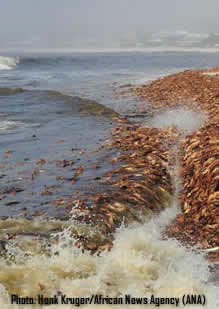Red tide season and the West Coast Rock Lobster walkout on the West Coast
09 February 2024
Large numbers of dead marine animals have been washing up on the beaches in the West Coast due to the annual red tide. These mortalities, including large numbers of prawns, crabs, cuttlefish, seaworms and shark rays, and many species, were first reported from the Berg River mouth area close to Velddrif, and mostly inside the estuary. Small numbers of lobsters were also present, both at the mouth of the estuary and adjacent shoreline.
The Department of Forestry, Fisheries, and the Environment (DFFE) would like to caution members of the public not to eat the washed-out marine animals. The appearance of washed-up lobsters carries significant health risks, rendering them unsuitable for consumption. Uncertainty surrounding their time of death, coupled with potential contamination by algal toxins, poses dangers to human health. Ingestion of these toxins can lead to severe adverse reactions and even fatalities.
The Department, in collaboration with various national and local authorities, has swiftly responded to the walkouts through the West Coast Rock Lobster Walkout Contingency Plan. This comprehensive plan involves collecting live lobsters, relocating them to areas with normal oxygen levels, and ensuring the safe disposal of deceased lobsters. Simultaneously, scientists closely monitor the red tide, document the species washed ashore, and conduct analyses, including size- and sex composition.
Large-scale lobster walkouts have profound consequences for both the marine ecosystem and local economies. Recent research by the Department’s Crustacean Research team uncovered substantial reductions in lobster densities following walkouts of 550 tons in 2022 and 100 tons in 2023, particularly impacting Elands Bay. This decline in lobster density translates to reduced catches in subsequent seasons, exacerbating economic challenges for West Coast fishing communities heavily reliant on the lobster resource.
Red tides are algal blooms, that is, accumulations of large amounts of phytoplankton (single-cell algae) that are common during late summer and autumn along the West Coast (St. Helena Bay area including Elands Bay, Dwarskersbos, Doring Bay, and Lamberts Bay). These are mostly harmless, but some are not, and therefore are referred to as harmful algal blooms or HABs. These blooms may be harmful due to their toxicity and/or due to their drastically reducing oxygen levels in the sea as they begin to decay. These, in turn, often result in mass mortalities of marine organisms. Possibly the best-known impact is on the West Coast rock lobster (Jasus lalandii), locally called kreef. Mass mortalities of this species are called “walkouts.” When oxygen levels drop, lobsters move inshore where wave action causes mixing of the water and slight increases in levels of oxygenation. When low tide sets in, they are left behind on the beach or are washed up on the beach by the waves.
During the late summer months, female lobsters migrate towards shallower inshore waters where dissolved oxygen levels are higher. This strategic movement is aimed at optimizing conditions for the development of eggs during the berry stage of reproduction. Due to their natural habitat preferences, females and juveniles tend to arrive earlier in these shallow areas compared to males. Consequently, they are more prone to becoming stranded on beaches, leading to a disproportionately higher number of lobster fatalities among females during this period.
For media enquiries, please contact:
Peter Mbelengwa
Cell: 082 611 8197


